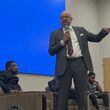Sunday morning in a hotel conference room just north of Dallas, the College Football Playoff selection committee will finish hours of discussion to decide which four teams deserve to compete for the national championship, and what the seeding should be.
To help decide among teams often inseparable by record and other factors like conference championships, strength of schedule or the “eye test,” committee members like former Nebraska coach Tom Osborne, former Secretary of State Condoleezza Rice and Clemson athletic director (formerly of Georgia Tech) Dan Radakovich will rely upon statistical data to compare teams.
That data will be furnished upon a data platform created by two brothers from metro Atlanta and two business partners also from Atlanta. When they’re not real-estate brokers, a health-care analyst and a software developer, Scott and Stephen Prather and business partners Drew Borland and Marty Couvillon are influencing college football decision makers in a variety of unseen ways.
Even better, the company’s genesis traces back to a mock business plan that Stephen Prather came up with for an assignment in an MBA class.
“It’s pretty cool that somewhat of a half-cocked idea back in 2005 kind of gets revived in 2009 and, just a couple years later, we’re sitting in there in the committee room with Condoleezza Rice and some of the biggest players in college football and are playing a part,” said Stephen Prather, who is a Marist School graduate who played baseball at Vanderbilt and is now a real-estate broker outside of Nashville, Tenn.
The company, SportSource Analytics, provides the committee with its data analytics platform. The custom web-based platform enables committee members to compare two or more teams across about 100 different statistical categories.
“The amount of data that they pulled together is amazing,” Radakovich said in an interview this summer. “So you pick out a few pieces of that that are maybe important to you.”
Data supporting observations
Part of the system is a simple way to measure teams while adjusting for schedule strength. Whatever the category – scoring, yards per play, third-down percentage, etc. – a team’s performance is measured against its opponents’ average in the same category over the course of the season. For example, if a team scores 20 points per game and all of its opponents average 10 points allowed per game, the team gets a 200 percent score in relative scoring.
“They’ll say in the meeting, ‘Hey, Team X is No. 3 in relative total offense,’” said Bill Hancock, CFP executive director. “Someone else will say, ‘But look at Team Y. Across the board, they’re strong across the defense.’ It’s like the data supports what the committee members observe.”
Hancock assured that SportSource Analytics’ data would be part of the discussion as the playoff field was determined this weekend.
“Two or three teams might look alike. They might all be 12-1 or whatever,” he said. “Then the committee looks at so many elements to try to differentiate between those teams, and the data’s a part of it.”
Data-driven approach
The four partners don’t try to hide the serendipitous manner in which the company has emerged to become a player in the billion dollar business of college football. Both Prathers are in real estate, and, around 2009, when the market was tanking, they considered Stephen’s class assignment as a possible second job. Both are big college football fans and value the data-driven “Moneyball” approach to decision making.
Stephen Prather asked Borland, his college teammate and close friend who has a background in software design, for advice. Borland wanted in and designed the platform, which is fed by the play-by-play information available on game reports on schools’ websites. Couvillon, a software developer who lives in Duluth, was operating the website cfbstats.com before the site was incorporated by SportSource about a year and a half ago. He is now a partner.
“So much of success can come down to timing and a little bit of luck,” Stephen Prather said. “The lucky part for me was one of my best friends is Drew Borland.”
Not long after the four-team playoff was formed in 2012, they were connected with the playoff office through a tweet sent from the SportSource Twitter account to CFP chief operating officer Michael Kelly. It turned out that playoff officials were looking for just that sort of data provider, and a match was made.
Products for coaches, ADs
Their influence does not end there. After a first venture geared more towards fans failed, they have hit with two other products, one for coaches and the other for athletic directors. The coaching product, Coaches By The Numbers, helps coaches self-scout and also break down opponents with most game data from 2001 and every FBS snap starting in 2005.
A coach (or more likely a grad assistant) can instantly access, for instance, how efficient a team’s offense has been on third-and-short in the red zone in conference losses in the past three years or how often a team will score when it has a play of four yards or more on the opening possession of a drive. Borland, whose day job is in health-care analytics, said there are 100 million statistical data points to draw upon.
“You can’t get that on ESPN,” he said.
About 25 teams are clients, including Tech, Oregon, Notre Dame, Wisconsin, Virginia, Arizona State and Penn State. First-year Houston coach Tom Herman, the former Ohio State offensive coordinator who is the architect of one of the season’s biggest turnarounds, is among the more noted users of the product.
“What we say is we’re above arithmetic but below calculus,” Scott Prather said.
The product for athletic directors includes statistically-driven dossiers on coaches and coordinators and a platform that can break down, for example, how a coach’s defense held up after his defensive coordinator left. Or, it can filter data from the past 15 years on how college defensive coordinators, former NFL head coaches or non-power conference head coaches (among other categories) between the ages of 40-44 have fared in their first job as head coach.
Oregon State, SMU and Houston used it last year, and six more schools are using their services this cycle.
“It’s not, like, cheap, but we’re not charging anywhere close to what search firms charge,” said Scott Prather, a Lassiter High grad who played baseball at Georgia Tech and then five years in the minor leagues.
The product is the result of Stephen Prather’s class project when he was earning his MBA at Vanderbilt after a four-year run working on Capitol Hill. He had long scratched his head at athletic directors who hired coaches based on nebulous qualities such as “knowing the culture” or “energy.” He recognizes that data isn’t king, but believes it can and should inform hiring decisions. They equate hiring without scrutinizing data to investing in a company without investigating the balance sheets.
“Go start researching a little bit defensive coordinators at power-five jobs,” Scott Prather said. “You’ll get a taste of what we’re talking about. You’ll ask yourself, ‘Is Kirby Smart a good hire for the University of Georgia?’”
Not that the company needs confirmation, but it was honored by the Technology Association of Georgia with the 2015 Business Intelligence Innovation Award, which Borland called “a huge honor.”
‘Luck meets opportunity’
All are college football fans. Scott Prather, now a real-estate agent living in Smyrna, shares a suite at Bobby Dodd Stadium with friends. He claims to have missed just one home game in the past 10 years (regrettably, it was this season’s Florida State game). Borland spends his Saturdays watching games in his basement on seven televisions.
All four, in their 30’s and 40’s, are married with children. None are quite ready to make the leap to making this a full-time job. For now, they’ll have to be satisfied with having a second job that helps inform decisions on everything from what plays are called from the sidelines to which coach gets hired for which job to which teams play for the national title.
“It was literally a luck-meets-opportunity situation,” Scott Prather said. “We worked hard building what we got, but it was the right place at the right time and we were able to get in front of the right people. It kind of snowballed from there. We’re very, very grateful to have this opportunity.”
It perhaps goes without saying: Stephen Prather isn’t positive, but he thinks he got an A on his project.






